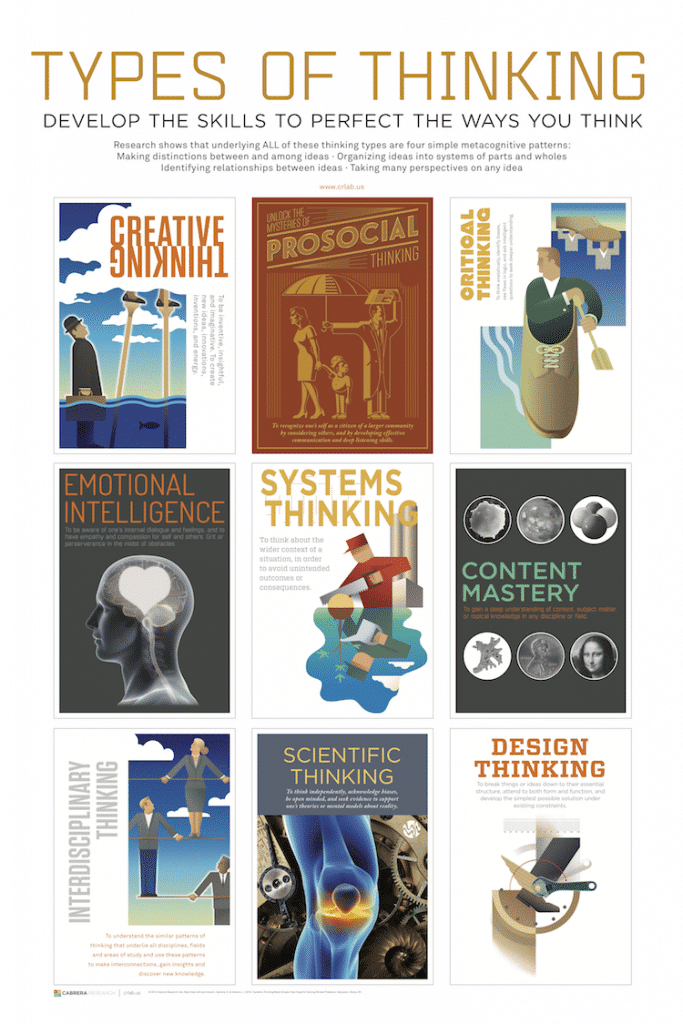I’ve always been fascinated by pictures of Planet Earth from outer space, especially those at night. You recognise the planet, then the plethora of illuminated cities. The largest ones seem globes of light in the night. Smaller cities look more like bland spots. In some areas, you can also see the main roads connecting the towns. Sometimes you see an isolated light place in the middle of the night. You still own a clear perception of the planet versus the deep black of the outer space. Perceiving this, the whole composed of the parts, as well as the relationship between the components, is Systems thinking, the critical skill that I will illustrate in this post.
In a recent post, I wrote about the dangers of Thinking in categories. I pointed out that to overcome the limits of categorical Thinking, it is necessary to drive models and tools of what is called “Systems Thinking”. However, it’s not just a question of means: I genuinely believe that Systems Thinking should be seen as a skill, and ability to foster and develop, and that is particularly needed in a moment of significant technological disruption.
What is Thinking?
We need to first start from defining what Thinking means. A possible working definition of Thinking is how we build meaning from information. In the last years, there have been multiple areas of the Thinking realm that have been investigated, both from a skills perspective as well as from different tools and methodologies.

The illustration above shows that many definitions exist, including Design Thinking, that we have already seen. Which leads very often to the discussion on whether we are talking of an identifiable skill or not. For sure Thinking is a human attribute. And for sure, there are different thinking styles. And toolkit that enhances our effectiveness in Thinking. But is there truly a skill set that supports what we intend as System Thinking?
What is System Thinking?
The concept of System Thinking derives from the work of Prof. Jay Forrester from MIT, a pioneer in computer models that in 1956 created the System Dynamic Group: Using data and technology, System Dynamics models the relationships between all the parts of a system and how those relationships influence the behaviour of the System over time. From this early definition, we can immediately grasp the fact that the original focus was on methodologies, tools and computer programming, and a great deal of development in the System Theories has helped to create a space for System Theories in the domain of management. As mentioned above, however, this is not the direction I’m more interested in. I want to explore the concept of System Thinking as a skill or set of skills.
From this point of view, the concept of Systems Thinking is often associated with that of Holistic Thinking. I believe considering them as pure synonyms are however not correct. The mistake is usually made by trying to find an opponent to Analytic Thinking. If through analysis, we deconstruct a whole to its most basic components, the contrary is holistic Thinking, which is to consider the “complex whole” together.
to break things down into parts (reductionism) is an act of systems thinking as much as seeing things in the context of their whole. A healthy part-whole balance is a necessary aspect of systems thinking.
Derek Cabrera, Systems Thinking is not the same as Holistic Thinking
True Systems Thinking therefore considers both perceptions, the analytic and holistic ones.
Another typical approach opposes the concept of Systems Thinking to that of Linear Thinking. Also here I don’t think this opposition is truly valid because the reality is that Thinking in terms of Systems also means understanding when to apply a linear thinking style and when to apply iterative techniques.
I genuinely like the approach identified by Derek Cabrera, that has defined the basic patterns of System Thinking through an Acronym: DSRP. In his book “Systems Thinking Made Simple“, the author details these four patterns:
- Making Distinctions – which consist of an identity and an other
- Organizing Systems – which consist of part and whole
- Recognizing Relationships – which consist of action and reaction
- Taking Perspectives – which consist of point and view
This means that the act of Thinking is primarily about making sense of the parts (through distinctions), but also of the context (how the parts relate to the whole), and their relationships in all directions (which is a central part of the process). Having a point of view is, however, where the Thinking becomes systematic synthetizing the observation in accurate judgement.
Here below there’s a video, produced by Cabrera, which illustrates the four patterns.
How do I help others becoming System Thinker?
Awareness of the four patterns above really gives us credit in how we can develop our Systems Thinking skills. But it’s not the easiest of the things. Adopting a system thinking approach takes persistence, intentionality and curiosity. Being the sole system thinker in an otherwise exclusively linear thinking organisation can be a pretty lonely place (and I know this from experience!). Some people will not understand you; some others will be confused, observing how you “jump” between contexts they don’t grasp.
“Making the Shift” is not easy, and the table below illustrates some possible tactics.

Move from the Symptom to the Problem
One of the easiest way to see System Thinking in practice is when people tend to concentrate on trying to solve a symptom, rather than go to the root cause and identify the underlying problem. How often does this happen in organisations? Multiple times per day in my experience.
Good Managers, therefore, apply System Thinking to identify the problem, which usually turns to solve the symptom(s) determined. In the process, we need to be careful not to lose some of the team members. People that are not used to Thinking in Systems get easily overwhelmed by the amounts of options that System Thinking delivers, and might get in a state of paralysis as they try to understand the impact of their activities across so many options. Which often leads to decision-making paralysis.
A great way to start can also be making sure we are capable of identifying systems. I suggest you read the article by Daniel Kim Introduction to Systems Thinking as this will help in rationalising some of the aspects of the systems thinking theories.
Let’s check this up
Let’s do a pulse check on how you are personally doing on Strategic Thinking. In this case, however, I won’t suggest a questionnaire about you applied Design Thinking in the past, but instead use the DSRP model we have seen before, and decline it in several questions, that you can apply to any issue. Beware, the patterns are not articulated in a linear process. But preferably in a continuously iterative loop. Think about fractals and how the iterative process continues to identify relationships. This is how systems Thinking works.
Distinctions
- What is __________?
- What is not __________?
Systems
- Does _________ have parts?
- Can you think of _________ as a part?
Relationships
- Is ________ related to __________?
- Can you think of ________ as a relationship?
Perspectives
- From the perspective of __________, [insert question]?
- Can you think about ____________ from a different perspective?
And for you? How vital is Systems Thinking in your world?

What Skills for the Future of Work?
This post is part of a series of articles on Skills and Competencies required to succeed in the Future of Work. Read the main article, and access all the other available posts.
Cover Photo by Annie Spratt on Unsplash

[…] organisms, that need to be considered holistically. This is the fundamental principles that Systems Thinking adds to the perspective of Organisational Design, and we should consider this. Reasoning only […]
[…] To achieve this, Kegan and Lahey introduce a Heuristic Four-Box model, that looks at change by looking at the distinction between the individual and the organisational and between the exterior and interior. The author of this model is Ken Wilber. His motivation as he designed this model was to remind people of their tendencies to look at broad phenomenon only through too few lenses. A problem we have seen when we have talked about Systems Thinking. […]
[…] I guess you can immediately see the powerful combination with Systems Thinking, which has been the subject of a recent post I wrote. […]
[…] HR is being considered a critical success factor in the future. I believe this to be an essential skill for the future of management as a whole, but I agree on its importance for HR, especially as it grounds its basis on Organisation […]
[…] of systems can help us overcome the limits of categorical splits. And I genuinely believe that Systems Thinking needs to be seen not just a toolkit or methodology, but as a skill to be developed and built for […]
[…] to create instead deliberate connections between individual goals and corporate purpose, and a holistic and Human-Centered view on Incentives as part of your organisation design effort, we will continue […]
[…] The critical first step in designing and leading successful large-scale Change is to understand the dynamics and performance of the enterprise fully. Leaders need a comprehensive roadmap for understanding performance issues in today’s complex enterprises. The Congruence Model of organisational behaviour developed by David Nadler and Michael Tushman at Columbia University is a simple, pragmatic approach to organisation dynamics based on systems thinking. […]
[…] to what is proposed by Naomi Stanford but requires many more tools and a truly systemic view of change. After all, we have seen some already advocate for an entire branch of Science of Intentional […]
[…] them in terms of Intentional Design to your organisation. At the same time, adopt a Systems Thinking view to allow a genuinely holistic […]
[…] thinking and design thinking approach you can check out two possible areas for a quick overview- systems thinking or design […]
[…] Decision MakingBe Deliberately DevelopmentalSystems Thinking […]